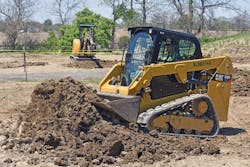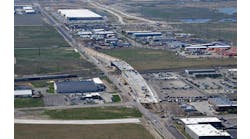By Eric K. Fisher, Contributing Author
Faced with a shrinking workforce, Hoosier highway contractors, the Indiana Department of Transportation (INDOT) and industry organizations convened in December 2019 to create an innovative civil construction pathway (CCP) for Indiana high school students. The CCP prepares students for meaningful careers building and maintaining the state’s infrastructure and creates a direct pipeline to paid pre-apprentice programs after graduation. During the 2021-22 school year, three schools welcomed their first group of students into the CCP and a fourth high school will begin in the fall of 2022.
Curriculum and lab activities focus on asphalt and concrete paving, bridges, construction inspection, erosion control, flagging, formwork, heavy equipment operation, roads, safety, soils, and surveying. The pathway combines the National Center for Construction Education Research (NCCER) Heavy Highway Construction Curriculum with hands-on construction experiences to create student excitement and interest.
Authentic student experiences are at the core of the CCP, and most of those occur in the Sandbox, an outdoor classroom created to bring students and industry partners together – building relationships through learning activities. In the Sandbox, students turn classroom lessons into real-world applications. To date, students have operated skid steers and excavators and performed directional drilling and hydro excavation. They’ve mixed, tested, pumped, placed and finished concrete, and then demolished their work the next week. Each Sandbox session allows students to explore all the skills and tasks necessary for building highways, roads and bridges. It also gives industry partners the opportunity to meet and teach students, developing relationships that can ultimately culminate in job offers. But employer partnership and hands-on experiences don’t end in the Sandbox. Jobsite visits play an important role in the pathway. Because it’s impossible to simulate some common horizontal construction situations in the Sandbox, students have visited jobsites that include hot mix asphalt (HMA) placement, soil stabilization and off-ramp exit slope grading. They toured INDOT’s North Split project updating the I-65 and I-70 interchange and learned about the skilled trades required for a job of that size. The highly mechanized scope of work for that particular project inspired several would-be heavy equipment operators.
Understanding building materials is vital for future road builders, and materials producers have played a critical role enhancing the student experience. In partnership with local producers, CCP students have created and tested reinforced concrete pipe, watched the aggregates pour into the hoppers of an HMA plant and explored a quality control and quality assurance lab to better understand the execution and verification process of construction specifications and contracts.
In 2022, a student-favorite activity was a ready-mix truck skills competition. Students even worked alongside industry partners to measure and score the highly skilled mixer truck drivers. They participated in a poster contest, concrete written knowledge test, and a mixer truck chute skills simulator that required them to carefully place a basketball into a hoop. Industry-recognized certifications are an essential piece of the civil construction pathway. They prove to employer partners that students have mastered specific skills in high school. Currently, CCP students can acquire flagging, Occupational Safety Health Administration Construction Safety (OSHA-10), skid steer and mini-excavator certifications. Future certifications will include aerial lifts, forklift, scaffolding and commercial driver’s licenses. Students with these certifications are valuable job candidates who are ready for immediate success on a heavy, highway and utility construction site.
The civil construction pathway has opened doors to educators as well as road builders. Industry partners are now reaching out directly to construction teachers in Indiana high schools to collaborate and recruit students. These interactions also, more importantly, include parents and guardians in the civil construction career exploration. Students hear what a job pays, but parents and guardians want to know about the risks and benefits. Educating the entire family together is essential, so they understand that a career in civil construction is a strong alternative to a traditional, four-year college degree. Once they sign on, students can participate in a paid internship during their senior year of high school. This partnership between the CCP and employers builds relationships which continue to build and improve the pathway for everyone involved.
The phrase “well that’s the way we’ve always done it” not only exists in the construction industry, but it unfortunately exists in construction education as well. Most construction educators have a background and experience in residential construction, and many teachers use it as a second job to make ends meet. Therefore, it’s extremely difficult to persuade teachers to add the CCP. This is where the horizontal construction industry can offer help and expertise. It has the skilled trades workforce to provide student demonstrations and teacher training. The CCP provides creative support to construction educators to help them succeed.
The final component to the CCP is a robust teacher training supported by employer partners. In 2021 and 2022, Indiana has hosted two cohorts of 10 teachers representing nine high schools each year for a weeklong training session. Supported by INDOT and funded by an On the Job Training Supportive Services Funding Grant, this paid professional development opportunity informs teachers about the different skilled trades and the equipment, materials and methods to build today’s sophisticated infrastructure. The goal is to get teachers to the training, and from there, help them implement the program. Perhaps the most important takeaways from CCP teacher training are the strong bonds forged between industry partners and teachers. From facility and jobsite tours to a round of golf at a summer outing, building these connections with construction educators is how Indiana’s horizontal construction industry gains access to the next generation of skilled trade workers and their families.
Indiana’s horizontal construction pathway continues to gain momentum as educators and industry partners learn course offerings. Two high schools have already committed to sending faculty to the 2023 teacher training session, and several other schools are considering the opportunity to expand their construction course offerings.
Born from a need to identify and support students who might not be compatible with a four-year college prep education plan and for those employers looking for career-ready graduates, the civil construction pathway has quickly grown in the past two years. It provides a solid foundation to attract young talent to the Hoosier highway, heavy and utility construction industry. R&B
Eric K. Fisher is the director of talent development for Indiana Constructors, Inc.



